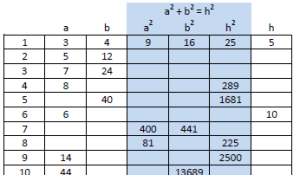Welcome.
I’ve been trying a lot of new things this year and I thought I would share my most recent experiment with you all. It was time to introduce Pythagoras to my Year 8 (accelerated) class. Here’s how I went about it.
Lessons 1 and 2
Firstly, I introduced the notion of doubling the square via the above video, which you can view on this page. http://mathforlove.com/2012/02/pythagorean-theorem-part-1-video/
I stopped this video a few times to get student input. The first stoppage was at the 25 second mark, where I asked the students for ideas on how we can get a square twice the size of the first. They were reluctant to offer suggestions, but at least none of them suggested a 2×2 square. I was a little disappointed that I couldn’t get to discuss the error of that approach, but quietly happy that they were perhaps smart enough to know that wouldn’t work.
The second stoppage was at 1:10 (where asked) and I had the students look for ways to get half that square. For this, I handed the students a piece of square paper (I have origami paper so I used that but any square paper would work). One student was onto the solution straight away, but some of the others struggled a little till the solution was passed around. I found this exercise quite useful and the students seemed to like it.
The third stoppage was around the 3:00 mark where I asked students to calculate the area of the square as shown above. For this I handed out centimeter-grid paper which I created and printed from the following site. http://www.math-aids.com/Graphing/Graph_Paper.html I also set the students the task of calculating the area of squares for 1×3, 1×4, 1×5 and 3×4 diagonals.
I found this an excellent task. The students really got involved and were genuinely engaged. I was surprised at the number of students who had some difficulty drawing these squares on the grid paper, they didn’t understand the nature of the right-angle and had no process for ensuring that the diagonals were going to the right place. They could see that they didn’t get a square (they got parallelograms generally) but couldn’t figure out where they went wrong.
We built a table on the board of the side lengths and the areas and many of the students offered suggestions on patterns they thought were evident. I think next time I do this I will pick different side lengths so that one basic (but incorrect) pattern doesn’t appear. The students didn’t manage to come up with the pythagorean theorem themselves, but were easily led to the pattern and I sensed that they were happy to accept the pattern. At this stage, we hadn’t even discussed triangles.
For the second part of this lesson I had the students construct their own right angled triangles (using the same grid paper from above to provide the right-angles) and measure the side lengths. I then had them fill in the a, b, a2, b2, a2 + b2 + c2, c table and verify for themselves that it all worked (within the margin of error). This part of the lesson didn’t go quite as well as I had hoped and I need to work on something here for next time.
The above took the better part of a double lesson and we resumed the next day.
Lesson 3
On the second day (third lesson) I had the students start with the above “puzzle”. I like to start off with puzzles and the students jumped into this one with gusto. I think the reason they took to it so well was that it was easy and there was little “thinking” involved. The PDF file is available for download here : pythagorean triples PDF The students got about 2/3 of the way through this file and started complaining about the repetition, and I suspect I need to cut the sheet down some for next time.
From here, I then proceeded to discuss Pythagoras Theorem and finding side lengths of triangles.
What I’ve found is that many students are more than happy to use the process from the above table to work out all their Pythagoras questions now. They don’t want to set out the work in what I would call a “classic manner” (formula, substitution, manipulation, answer) but will happily write the numbers, square them and work out the missing values.
While I’m happy that these students actually understand the concepts involved, they’re complaining about the amount of time it takes to complete each question and I recognise that we need to do something about this at some point in time.
Overall, I’m happy with the way this intro to Pythagoras went. The students mostly enjoyed the activities and are more than comfortable with the “arithmetic” of Pythagoras. They are struggling with the “layout” and “rigor” I require but can do the Math which is more important at this stage I believe.
For next time, I think I need to work on the transition from the “calculate the area of the squares” to “measure the sides of the triangles”. Perhaps I can get the students to create their own diagonals and work on those. I also need to reduce the size of the “puzzle” I gave the students and work on the transition from that puzzle to the application to Pythagoras type questions.
I’m very happy that the students actually understand the concept of the squaring of sides of the triangles but I would be happier if the students were able to introduce a little more “rigor” into their working. Perhaps that’s just a hold over from the old me?
Comments and Suggestions are welcome.
Cheers,
Chris.







